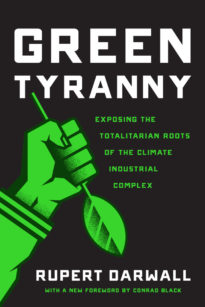Mankind’s subservience to the commands of nature provides the connecting thread between Nazism and modern day environmentalism and represents a radical rejection of the Enlightenment’s belief in progress. It is what separates the New Left and the modern Left’s softer variants from their predecessors and leaves supporters of capitalism and markets as the last redoubt of belief in the potential of mankind’s unfettered material progress.
‘This striving towards connectedness with the totality of life, with nature itself, a nature into which we are born, this is the deepest meaning and the essence of National Socialist thought,’ wrote Ernst Lehmann, a professor of botany, in 1934, who characterized National Socialism as ‘politically-applied biology.’ Sixty percent of all biologists joined the Nazis. As Proctor points out, ‘Nazism took root in the world’s most powerful scientific culture, boasting half of the world’s Nobel prizes.’ The culture that gave rise to it existed before the rise of the Nazis and, as we shall see, though dormant in the three decades after 1945, would re-enter German politics in the late 1970s with environmentalism and anti-capitalism as two sides of the same coin.
Mankind’s subservience to the commands of nature provides the connecting thread between Nazism and modern day environmentalism
In 1917, Fritz Lenz, a geneticist, wrote an essay Race as the Principle of Value: On a Renewal of Ethics. Hitler’s library contained an offprint of the essay. Lenz argued that the growth of technology had brought about an alienation from nature. When it was republished in 1933, Lenz boasted that the essay ‘contained all the main features of the National Socialist worldview.’ Urbanized, industrialized man’s breach with nature is a recurrent theme. In 1932, the surgeon and cancer specialist Dr. Erwin Liek, widely credited with being the father of Nazi medicine, wrote a book arguing that cancer was a disease of civilization.
Cultural hostility to urban civilization in Germany pre-dates Nazism and not all those who articulated it became Nazis. In 1913, the philosopher Ludwig Klages, a conservative later criticized by the Nazis, wrote an essay Man and Earth. Staudenmaier detects in it virtually all the themes of today’s environmental movement. Progress was ‘a sick, destructive joke,’ Klages wrote, its final goal being
nothing less than the destruction of life. This destructive urge takes many forms: progress is devastating forests, exterminating animal species, extinguishing native cultures, masking and distorting the pristine landscape with the varnish of industrialism, and debasing the organic life that still survives.
The trigger for Hitler’s political awakening appears to have come from a 1919 lecture by the economist Gottfried Feder, a founder of the Deutsche Arbeiterpartei (DAP), the German Workers’ Party. ‘As I listened to Gottfried Feder’s first lecture about the “breaking of interest slavery,” I knew at once that this was a theoretical truth which would inevitably be of immense importance for the future of the German people,’ Hitler wrote in Mein Kampf, the solution being ‘the sharp separation of stock exchange capital from the national economy.’ According to Hitler, Feder had exposed ‘with ruthless brutality’ the economic character of stock exchange and loan capital – ‘its eternal and age-old presupposition which is interest.’
As an approximation, subtract Nazi race-hate, militarism and desire for world conquest, then add global warming and Nazi ideology ends up looking not dissimilar to today’s environmental movement.
From this economic critique emerged what Tooze argues is the originality of National Socialism. Hitler’s hatred of Jews led him to reject accommodation with a global economic order dominated by affluent English-speaking countries – manifested for him in Wall Street Jewry and the Jewish media – and mount an epic challenge to overthrow it. ‘Right after listening to Feder’s first lecture, the thought ran through my head that I had now found the way to one of the most essential premises for the foundation of a new party,’ Hitler wrote. In September 1919, Hitler joined the DAP as its fifty-fifth member. The following February, the German Workers’ Party added ‘National Socialist’ to its name, becoming the NSDAP – the Nazi party.
The Nazis’ profound hostility to capitalism and their identification with nature-politics led them to advocate green policies half a century before any other political party. As an approximation, subtract Nazi race-hate, militarism and desire for world conquest, then add global warming and Nazi ideology ends up looking not dissimilar to today’s environmental movement. From the vantage point of the second decade of the 21st century, it might come as a shock, but should not surprise that Hitler and the Nazis were the first to advocate large-scale renewable energy.
1932 was a crucial year for the Nazis. The stock market had crashed in 1929 and the Great Depression fatally undermined the parties supporting the Weimar democracy. The first round of the presidential election was scheduled for March 13th. Hitler was the leading candidate to defeat incumbent Field Marshal von Hindenburg. Two-and-a-half weeks before the election, the Nazis’ newspaper, the Völkischer Beobachter, carried a long article reporting a ‘sensational speech’ on plans for huge 70-90 meter high (230-295 feet) wind mills to generate ‘huge amounts of cheap energy.’ In the speech, Hermann Honnef of Berlin’s Institute of Physics, explained how electricity from the towers could be combined with hydro-power, which would be responsible for delivering base load electricity, whilst surplus electricity from wind farms located along the coast could be stored by producing ‘very inexpensive’ hydrogen – a green dream that to this day remains just that.
It might come as a shock, but should not surprise that Hitler and the Nazis were the first to advocate large-scale renewable energy.
Headlined ‘National energy policy,’ the article claimed that wind power could transform the economy and give employment to millions of Germans (‘green jobs,’ in today’s political parlance). There would be greater fuel economy through light-weight cars and trains, and tariffs would encourage car drivers to switch to rail. Cars would also use domestically-produced synthetic fuels. The program would completely change the whole economy, the article concluded, improve money circulation and reduce imports and cost burdens. This must be one of the first efforts at describing ‘green growth’ that would become popular with governments in the 21st century whereby making the production of useful energy less efficient would, by some alchemical process, help economies grow rather than do the opposite.
The same year, the party’s economic spokesman, Franz Lawaczeck, a founder of the Nazi architects and engineers association (Kampfbund Deutscher Architekten und Ingenieure), wrote a book, Technik und Wirtschaft im Dritten Reich. Ein Arbeitsbeschaffungsprogramm (Technology and the Economy in the Third Reich – A Program for Work). An early member of the NSDAP, Lawaczeck was an inventor of hydro-power turbines (the US Patent and Trademark Office granted him a patent for a turbine/compressor in 1917). Lawaczeck was on the left-wing of the party and associated with Feder, Julius Streicher, Heinrich Himmler and Joseph Goebbels.
The capitalist system was an experiment in liberal thinking that had led Germany to catastrophe
Technology and the Economy is both an anti-capitalist tract and a blueprint for a renewable energy future. Lawaczeck extolled the corporatist state that had been destroyed by egoistic liberal capitalism and denounced foreign trade as only benefitting traders. The capitalist system was an experiment in liberal thinking that had led Germany to catastrophe. The experiment was now over and everyone could see the consequences. Like many Nazis, Lawaczeck was impressed by Stalin’s Five Year Plans. In the race between liberal and state capitalism, the Bolsheviks would win, Lawaczeck believed.
On energy, Lawaczeck noted that coal had changed the world and attained an overwhelming dominance. Because it was so cheap, it was used wastefully and long-term priorities were not taken into consideration. Steam turbines used only one-fourth of the energy content of coal and locomotives used only one-twelfth. Instead of being used for energy, coal would be more valuable making chemicals and other products. By contrast, hydro and wind power were much more efficient, converting up to four-fifths of their energy inputs into useable energy. Those inputs were from Nature, ‘at hand to use, free of cost, but Man has weighed them down to an incredibly high degree with monetary interest.’
Large scale deployment of Nazi wind power never got off the ground. If it had, the Allies would have had an easier task in defeating Hitler
Lawaczeck argued that the future of wind power was with very large towers like high radio masts, at least 100 meters (328 feet) high, with 100-meter diameter turbines which, unlike modern turbines, were designed to rotate in a horizontal plan. Lawaczeck conceded that hydro and wind power suffered from intermittency. It was impossible to use hydro in winter or in dry, summer months. The situation was even more difficult for wind because of changes in wind speed. The system therefore had to store energy. Like Honnef, Lawaczeck foresaw energy from wind power being converted and stored in the form of hydrogen. The transformation to a hydrogen society would be an important step towards a new industrial revolution, Lawaczeck wrote. Germany could exploit this technology advantage; hydrogen-powered engines would be more powerful than petrol or diesel. It would be cheaper to manufacture and weld steel, giving German exporters a competitive advantage in world markets. It would enable Germany to export more and pay-off its national debt.
Why, asked Lawaczeck, was coal so dominant in capitalist societies and only five percent of Germany‘s potential hydro-power actually used? The answer lay in the upfront investment cost. Coal and oil cost about two hundred Reichsmarks (RM) per kilo Watt of generating capacity while the cost of investing in hydro ranged from 400 to 1,000 RM, Lawaczeck reckoned. However, modern research suggest Lawaczeck was too optimistic about wind. The theoretical maximum of a wind turbine is not 80 percent, as Lawaczeck thought, but 59.3 percent. In practice, the highest attainable power coefficient is around 47 percent. Because air is one thousand times less dense than water, the kinetic energy that can be taken from wind – even at optimal wind speeds of between 25 to 56 mph – is tiny. Thus the energy density of wind is only one sixteenth that of hydro and five orders of magnitude (nearly one millionth) less than petrol.
Wind, like hydro, requires huge amounts of capital. As Lawaczeck and the Nazis grasped – and modern governments would discover in their turn – the market would not provide the capital if left to itself. Echoing Feder’s breaking interest slavery, Lawaczeck argued that interest on money is the greatest obstacle to making wind and hydro-power profitable.
Large scale deployment of Nazi wind power never got off the ground. If it had, the Allies would have had an easier task in defeating Hitler.

